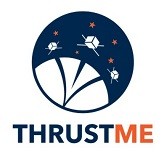ThrustMe announces its first contract with the European Space Agency


ThrustMe has been awarded a contract from the European Space Agency to demonstrate the world’s first iodine electric propulsion system in space.
Founded in 2017 by Ane Aanesland, Director of Research at CNRS, and Dmytro Rafalskyi, researcher at the Laboratory of Plasma Physics (LLP X-CNRs), ThrustMe was born because of the rise of small satellite constellations and their need for adequate in-orbit propulsion solutions to enable economic and environmental sustainability for the industry, and of space. ThrustMe has a portfolio of propulsion solutions for a wide range of satellites and space missions. In 2019 they made history with the demonstration of the world’s first iodine propelled spacecraft together with Spacety, one of the first commercial aerospace companies in China.
Existing space propulsion systems are not suitable for the next generation of satellites. Chemical propulsion solutions require too much propellant, while traditional electric propulsion systems need too much power, and most are too complex for streamlined production and integration. “But the biggest problem of all is the propellant. For ride share missions it is just not safe enough to use pressurized gas propellants, which in addition, can lead to very high direct and indirect costs in the overall use of propulsion, particularly with regards to testing, assembly, and launch integration”, explains Ane Aanesland, CEO of ThrustMe.
ThrustMe has demonstrated groundbreaking achievements in developing electric propulsion systems with unmatched performance for the new space paradigm. “We have leveraged the technology of our existing cold gas system, the I2T5, which was launched last year, and which was the first ever iodine propulsion system tested in space. Our new iodine electric propulsion system, the NPT30, uses plasma generation and beam neutralization technologies that have been under development at ThrustMe since 2017, and have already reached a high-level of maturity through extensive testing and qualification campaigns” says Dmytro Rafalskyi, CTO of ThrustMe.
While most electric propulsion systems currently use xenon propellant, it has become evident that this is not a viable long term solution. If we keep using xenon, the total space industry demand alone will exceed twice the global capacity of xenon production in the next 5-10 years. This is one reason why SpaceX, for example, are using krypton for their Starlink satellites. “But Krypton is just a quick fix before better solutions come along”, says Ane Aanesland.
Iodine has been considered a promising alternative propellant for over a decade, and is identified as a key strategic technology for space, due to its higher density, easier storage, and lower costs – this while still giving similar, or even better, thruster performance than xenon. Both NASA and ESA have initiated significant R&D programs for the purpose of developing technologies compatible with iodine thrusters, but so far, only ThrustMe has demonstrated the building blocks of this technology in space.
In 2019, the French Space Agency, CNES, supported the development of ThrustMe’s iodine technologies via a project as part of their R&T program.
*LPP: CNRS, Ecole Polytechnique, Sorbonne Université, Université Paris-Saclay, Observatoire de Paris.
 Support l'X
Support l'X